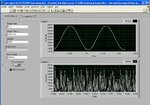Fisquietto
Newbie level 4
Hello,
We want to evaluate the performance of the CAN 16 bits AD7621. First of all, we want to extract the Differential non linearity and the integral non-linearity.
For that, the CAN is soldered on PCB board ( based on the evaluation board). We use a ultra low distortion function generator to drive the input of the device through 2 AD8021. The frequency is roughly 240 Hz
The sample clock is provided by a basic function generator.The frequency is 3MSPS
To extract the DNL and INL, we catch a lot of digitized data. we strobe the Busy output to be sure of data
When we compute the histogram, a lot of code are missing. At every run, the same codes are missing. Strange !!
a screenshot of the histogram is attached.
If you have an idea, Thank for your help.
We want to evaluate the performance of the CAN 16 bits AD7621. First of all, we want to extract the Differential non linearity and the integral non-linearity.
For that, the CAN is soldered on PCB board ( based on the evaluation board). We use a ultra low distortion function generator to drive the input of the device through 2 AD8021. The frequency is roughly 240 Hz
The sample clock is provided by a basic function generator.The frequency is 3MSPS
To extract the DNL and INL, we catch a lot of digitized data. we strobe the Busy output to be sure of data
When we compute the histogram, a lot of code are missing. At every run, the same codes are missing. Strange !!
a screenshot of the histogram is attached.
If you have an idea, Thank for your help.
